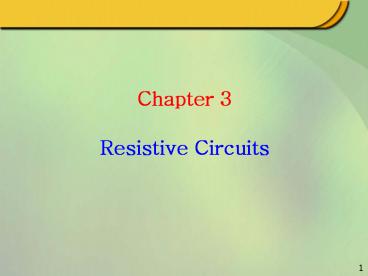Chapter 3 Resistive Circuits - PowerPoint PPT Presentation
1 / 28
Title:
Chapter 3 Resistive Circuits
Description:
(a)Circuit with dependent source and an ammeter ... (b) The circuit after the ideal ammeter has been replaced by the equivalent short ... – PowerPoint PPT presentation
Number of Views:26
Avg rating:3.0/5.0
Title: Chapter 3 Resistive Circuits
1
Chapter 3Resistive Circuits
2
Figure 3.1-1The circuit being designed provides
an adjustable voltage, v, to the load circuit.
Adjustable Voltage Source
Figure 3.1-2(a) A proposed circuit for producing
the variable voltage v(b) the equivalent circuit
after the potentiometer is modeled
3
Figure 3.3-1(a) An electric circuit. (b) The
same circuit, redrawn using straight lines and
horizontal and vertical elements. (c) The
circuit after labeling the nodes and elements.
Kirchhoffs Law
Example 3.3-1
Figure 3.3-2 Four circuit drawings.
4
Kirchhoffs Current Law (KCL)The algebraic sum
of the currents into a node at any instant is zero
Kirchhoffs Law
Kirchhoffs Voltage Law (KVL)The algebraic sum
of the voltages around any loop in a circuit is
identically zero for all time
5
Figure 3.3-4 (a) The circuit considered in
Example 3.3.2 and (b) the circuit redrawn to
emphasize the nodes.
Kirchhoffs Law
Example 3.3-2
Example 3.3-3
Figure 3.3-5Circuit with two constant-voltage
sources.
6
Figure 3.3-6(a)Circuit with dependent source and
an ammeter(b)Equivalent circuit after replacing
the ammeter by a short circuit
Kirchhoffs Law
Example 3.3-4
Figure 3.3-7The circuit of Figure 3.3-10 after
labeling the nodes and some element currents and
voltages.
7
Figure 3.3-8(a)Circuit with dependent source and
a voltmeter(b)Equivalent circuit after replacing
the voltmeter by a open circuit.
Kirchhoffs Law
Example 3.3-5
Figure 3.3-9The circuit of Figure 3.3-12b after
labeling the nodes and some element currents and
voltages.
8
Kirchhoffs Law
Exercise 3.3-1
Exercise 3.3-2
Exercise 3.3-3
Exercise 3.3-4
9
Figure 3.4-1Single loop circuit with a voltage
source vs.
A Single Loop Circuit Voltage Divider
- KCL - KVL
10
Figure 3.4-2Voltage divider circuit with R19?
A Single Loop Circuit Voltage Divider
Example 3.4-1
Figure 3.4-3Equivalent circuit for a series
connection of resistors.
11
Figure 3.4-4(a) A circuit containing series
resistors(b) The circuit after the ideal ammeter
has been replaced by the equivalent short circuit
and a label has been added to indicate the
current measured by the ammeter, im.
A Single Loop Circuit Voltage Divider
Example 3.4-2
12
A Single Loop Circuit Voltage Divider
Exercise 3.4-2
Exercise 3.4-1
Exercise 3.4-3
Exercise 3.4-4
13
Figure 3.5-1A circuit with a current wource.
Parallel Resistors and Current Division
Figure 3.5-2 Parallel circuit with a current
source.
Figure 3.5-3Equivalent circuit for a parallel
circuit.
14
Figure 3.5-4Set of N parallel conductances with
a current source is.
Parallel Resistors and Current Division
15
Figure 3.5-7(a) A circuit containing parallel
resistors(b) The circuit after the ideal
voltmeter has been replaced by the equivalent
open circuit and a label has been added to
indicated the voltage measured by the voltmeter,
vm.(c) The circuit after the parallel resistors
have been replaced by an equivalent resistance.
Parallel Resistors and Current Division
Example 3.5-1
Example 3.5-2
16
Figure E3.5-2(a) A current divider. (b) The
current divider after the ideal ammeter has been
replaced by the equivalent short circuit and a
label has been added to indicate the current
measured by the ammeter im.
Parallel Resistors and Current Division
Exercise 3.5-1
Exercise 3.5-2
17
Figure 3.6-1(a) A circuit containing voltage
sources connected in series(b) an equivalent
circuit.
Serious Voltage Source and Parallel Current
Source
Figure 3.6-2(a) A circuit containing parallel
current sources(b) an equivalent circuit.
18
Table 3.6-1Parallel and Series Voltage and
Current Sources.
Serious Voltage Source and Parallel Current
Source
19
Figure 3.7-1Circuit with a set of series
resistors and a set of parallel resistors.
Circuit Analysis
Figure 3.7-2 Equivalent circuit of Figure 3.7-1.
20
Figure 3.7-3(a) Circuit for Example 3.7-1. (b)
Partially reduced circuit.
Circuit Analysis
Example 3.7-1
Figure 3.7-4 Equivalent circuit.
21
Figure 3.7-5.
Circuit Analysis
Example 3.7-2
22
Figure 3.7-6The equivalent resistance looking
into terminals c-d is denoted as Reqc-d .
Circuit Analysis
23
Circuit Analysis
Exercise 3.7-1
Exercise 3.7-2
Exercise 3.7-3
24
Figure 3.8-1 (a) A resistive circuit and (b) an
equivalent circuit.
Circuit Analysis using MATLAB
Figure 3.8-2 Plot of I versus Vs for the circuit
shown in Figure 3.8-1.
25
Figure 3.9-1 (a) An example circuit and (b)
computer analysis using Mathcad.
Circuit Analysis using Mathcad
26
Figure 3.10-1 The circuit being designed provides
an adjustable voltage, v, to the load circuit.
Adjustable Voltage Source
Figure 3.10-2 (a) A proposed circuit for
producing the variable voltage, v, and (b) the
equivalent circuit after the potentiometer is
modeled.
Figure 3.10-3 The circuit after setting R1R2R.
27
Table 3.12-1Equivalent Circuits for Series and
Parallel Elements.
Equivalent Circuits
28
Problems 3.3 2, 4, 7, 9 3.4 2, 4,
6 3.5 2, 4, 6 3.7 2, 4, 6, 10, 14
Homework 2































